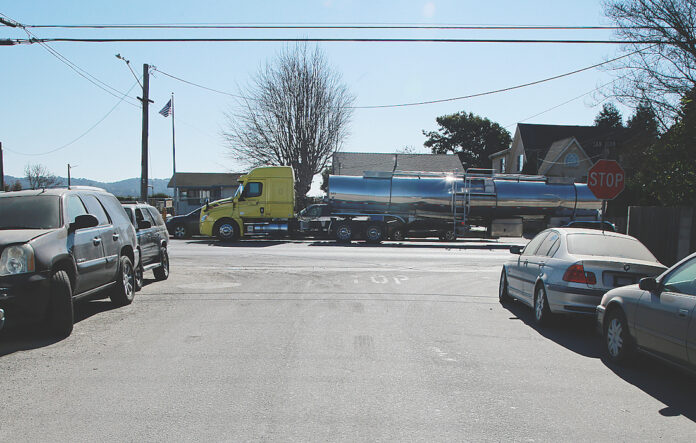PAJARO—The Monterey County Planning Commission on Wednesday delayed adopting a mitigated negative declaration (MND) for a 60-unit housing project in Pajaro, to give County staff time to provide notice to the people who live near the proposed site.
Residents have expressed alarm about the project, which would place four, two-story, apartment buildings for agricultural workers on a 3.41-acre property in the area of Susan and Gonda streets.
Christine Shaw, who lives on Gonda Street, says that neighbors—particularly ones that do not speak English—were not given notice about the possible adoption of the MND—a declaration by state officials that a project will not have significant environmental impacts.
Such a declaration—or alternatively an environmental impact report—is a key step in having a construction project approved.
“Something is not right here,” Shaw said “The wheels are being greased and I don’t know why.”
Monterey County Housing and Community Development Director Craig Spencer said that there has been no rush on the project and that it fits in with the County’s philosophy.
“The board has made it a priority for housing and community development to process all affordable housing projects,” Spencer said. “We’ve moved this to the top of the things we’re working on, but it’s following the regular process.”
But during the Tuesday meeting, Commissioner Kate Daniels said the project seems “unduly rushed,” and suggested that the meeting be held in the evening to give agricultural workers a chance to weigh in.
Commissioner Amy Roberts agreed and asked that translation services be provided at the next meeting.
Famila Sanchez, who lives on Susan Street, said that she had only found out about the meeting the night before it occurred.
“I don’t see many people in my community participating right now,” she said, adding that many people did not receive any notice. “We need more info.”
The Project
Along with the 60 apartment units on a small agricultural parcel at the dead-end of Susan Street, the project would consist of two laundry facilities, one manager unit and one recreation room for agricultural employees. It also includes a quarter-mile looped “fitness” pathway.
While the project would be occupied primarily during the Salinas Valley harvest season from April through November, some permanent residents are possible.
Each room would have “dorm-style” sleeping quarters that hold eight people.
The area is zoned “Farmland,” which allows a maximum building site coverage of 5%.
This application proposes to construct four buildings that would result in 26% coverage, and county officials are mulling a variance to allow the larger number, Spencer says.
Monterey County ordinance allows for variances when they meet certain criteria.
Concerns
Shaw worries that the project would add huge amounts of traffic to the narrow roads in her sleepy neighborhood.
“They want to propose moving 488 people down our street with buses mostly,” she said.
Shaw says she knows that it is unrealistic to try to stop the development, but says that the project would be better suited on a larger thoroughfare such as San Juan Road.
“I would hope they would have smart development that doesn’t have such a negative impact on the community,” she said.
Developer John Avila, whose eponymous construction company has built several similar farmworker housing projects from King City to Salinas, says the traffic concerns are overblown—a study shows traffic increasing from 400 vehicles to 800 vehicles per day if the development is approved.
In fact, Avila estimates that the fact that most of the residents will be bussed to their job sites will help mitigate the increased number of residents, adding only about 150 trips.
Shaw has taken it upon herself to talk to her neighbors about the project, and says she has gathered signatures from many of them opposing it. She also attends all the meetings associated with the project.
“It’s been a mess from the get-go,” she said. “We’ve had to fight to exercise our rights to have a say in what is going to absolutely decimate our community.”
Both Avila and Spencer say the neighbors have been properly notified, several different times for several meetings.
The Owners
The property is owned by Rio Vista Group LLC, a Salinas-based entity formed last year by Kevin Tottino of Ocean Mist Farms, Josh Stratton—chief of staff to Monterey County Supervisor John Phillips, Ronnie Alderete of Premium Packing and Cesar Padilla, who owns Castroville Tire.
Padilla, whose job brings him into constant contact with people from the agriculture industry, says the project fills two needs. In addition to providing much-needed, affordable housing for farm laborers, it also brings workers to the farmers.
“I speak with these people every day,” he said. “They all relay the message that they don’t have enough people to do the work.”
Padilla says he was inspired to put the project in Pajaro when he saw other similar developments that have been completed by Avila Construction, the Salinas-based company slated for the Susan Street project.
“We’re not interested in market-rate rentals—that’s not why we’re here,” he said. “We’re here to fulfill our little dream to alleviate our housing crisis. I believe it’s a solid project, it carries its own weight, it speaks for itself, and I hope the community will acknowledge how ideal and solid these projects are.”
The Developer
Avila acknowledges that residents are likely to see increased traffic and that the development could alter the neighborhood. But he says that his other developments have been successfully integrated with their respective communities. He points as an example to the 100-unit Tanimura & Antle Housing project in the Town of Spreckels.
Avila also says that the proposed site is already listed as a growth area.
“Planning professionals of the world over the last 20 years have pushed for this kind of growth in areas that are already developed for infill development,” he said. “This is like textbook—this is what you’re supposed to do.”
He adds that the projects are low-impact, and therefore warrant the negative declaration.
“The real physical result is that we have a great project that provides a huge community service by supplying badly needed housing, and we’re solving one of the many problems in the housing world with this product,” he said.









